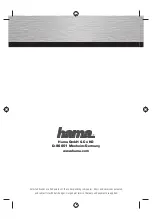
First set the Welding helmets rake and adjust the welding filter to suit personal comfort (See the helmet's
user instructions) Lift the helrnet to it's upper position. Place over the head and adjust the headgear ratchet
wheel by pushing it in and twisting until a satisfactory tightness is achieved. Pull the elasticaîed chin guard
downwards and at the same lime pull the helmet down. Ensure the elasticated chin guard fits comfortably
under the chin. The Welding helmet is now ready for use
5.3. Usage:
Switch on the unit by pressing the ON/OFF burton on the control panel. The airflow can be adjusted by two
arrow-buttons from 180 I/min up to 220 I/min.
The unit ensures a constant supply of air. The microprocessor inside the unit automatically regulates the
motor speed to compensate the filter clogging and the battery state. Il the microprocessor cannot keep the
adjusted airflow, the unit will sound a 'beeping' alarm (an acoustic signal can be heard). At which point the
user must check the blower unit. If possible, the microprocessor automatically reduces the airflow to the next
lower level, if it lails to meet the lower level, the alarm will still sound. When the airflow falls below the
minimum sale operating level, a second audible alarm joins the first and the unit will Vibrate. At this point, the
user must stop working at once, leave the working environment and reach an area nominated to be safe and
change the filter or recharge/change the battery.
To check the battery: When first starting the unit, the battery LED must show red – this shows a fully charged
battery. It is recommended that only a fully charged battery should be used when starting a work shift.
With a fully charged battery in place, the unit should function normally, but if the audible alarm still sounds,
the user must change the filter. If the problem still persists, see chapter 8 for additional suggestions.
6. Before use:
6.1 Inspection before use :
Each time belore starting work check that
All components are in good condition with no visible damage (Iike holes, tears etc) Replace any damaged or
worn parts. Carefully examine the air hose, seals and the face piece.
There is a good connection between the air hose and the headpiece as well as the blower unit.
There is sufficient air flow.(see 6.2.)
The air is supplied through the whole respiratory system from the blower to the hood.
Charge the battery before the first use. (see 6.3.)
6.2. Air Flow Test:
1.Disconnect the air hose fram the Blower unit.
2;Insert the Airflow indicator into the air hose connector and keep the hose in vertical position at about the
eye level.
3.Switch the power unit on. The airflow is sufficient only if the bail indicator reaches the minimum flow rate
level. If the indicator sinks is below the minimum flow rate level, it is necessary to charge the battery or
change the filter. If the problem still persists, see chapter 8 for additional suggestions.
6.3. Batteries:
NOTE! Batteries are delivered only partially charged, Ali batteries must be charged before they are used for
thefirst time.The battery can becharged separately oron the blower unit.
The charger must not be used for any other purpose than that for which
it
was manufactured. Do not charge
the battery in a potentially explosive atmosphere. The battery charger is intended for indoor use. It must be
protected against damp. The charger controls the charging automatically.
Alter the battery has been charged, the charger switches to the trickle charging regime and keeps the battery
fully charged. The charging time is 6 to 8 hours.
6.3.1. Battery charging:
1.Check that the voltage of the electrical power supply is correct.
2.Plug the charger into the socket.
3.Connect the battery to the charger. The socket of the battery is positioned on the back side.
4.The charging state is indicated by a red LED diode light.
5.After charging has been completed, the trickle charging regime is activated: -red LED Diode goes out, the
green LED diode comes on at the moment of trickle charging.
6.3.2.
Battery changing:
Removing the battery: Locate the battery catch. Pull back the battery catch and at the same time the Battery
can be removed by lifting upwards.
Fitting the battery: Make sure the battery is the correct way up (as per 5.2) and then slide into the bower until
the battery catch engages. It is essential that the battery catch is fully locked.
Summary of Contents for Airkos CR-2B01/2013
Page 1: ...Airkos CR 2B01 2013 Covers Helmets PL 2B01 2013 and GT 2B01 2013...
Page 2: ...5 1 5 2 1 5 2 2...
Page 3: ...5 2 3 5 2 5 5 2 7 5 3...
Page 4: ...6 2 6 3 6 3 2...
Page 5: ...10...































